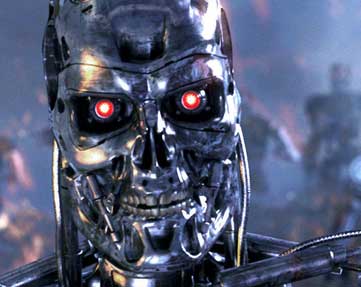Caltech Develops Self-Healing System for Integrated Chips
Self-healing chips are on the way, possibly leading to self-healing robots that take over the world and enslave mankind. Yay for science!
Integrated circuits are delicate entities, as even a single fault can render them completely useless. But a team of engineers at the California Institute of Technology (Caltech) want to change that by developing "self-healing" integrated chips.
Caltech reports that the team recently demonstrated the new tech using a high-power laser and a millimeter-wave power amplifier, the latter of which is a circuit used in next-generation communications, imaging and sensing applications. After some of the chip's components were fried by multiple laser blasts, the self-healing system kicked in, detected the faults, and then routed around them so the amplifier could function at near-optimum levels.
"It was incredible the first time the system kicked in and healed itself. It felt like we were witnessing the next step in the evolution of integrated circuits," said Ali Hajimiri, the Thomas G. Myers Professor of Electrical Engineering at Caltech. "We had literally just blasted half the amplifier and vaporized many of its components, such as transistors, and it was able to recover to nearly its ideal performance."
The power amplifier developed by the team uses a number of on-chip sensors that monitor temperature, current, voltage, and power. All this information is fed into the "brain" of the system, a custom application-specific integrated circuit (ASIC) unit on the same chip. It analyzes the amplifier's overall performance and determines if it needs to adjust the changeable parts of the chip, the system's actuators.
According to Steven Bowers, a graduate student in Hajimiri's lab, the ASIC unit draws its conclusions based on the aggregate response of the sensors. "You tell the chip the results you want and let it figure out how to produce those results," he said. "The challenge is that there are more than 100,000 transistors on each chip. We don't know all of the different things that might go wrong, and we don't need to. We have designed the system in a general enough way that it finds the optimum state for all of the actuators in any situation without external intervention."
Interestingly enough, the team discovered that amplifiers with self-healing abilities consumed around half the power of those without self-healing abilities. Even more, their overall performance was much more predictable and reproducible than standard amplifiers. Ultimately, the team learned that self-healing addresses four classes of problems: static variation, long-term aging issues, environment-related short-term variations and accidental/deliberate destruction of parts.
"Bringing this type of electronic immune system to integrated-circuit chips opens up a world of possibilities," said Hajimiri. "It is truly a shift in the way we view circuits and their ability to operate independently. They can now both diagnose and fix their own problems without any human intervention, moving one step closer to indestructible circuits."
Get Tom's Hardware's best news and in-depth reviews, straight to your inbox.
The team's results appear in the March issue of IEEE Transactions on Microwave Theory and Techniques.

Kevin Parrish has over a decade of experience as a writer, editor, and product tester. His work focused on computer hardware, networking equipment, smartphones, tablets, gaming consoles, and other internet-connected devices. His work has appeared in Tom's Hardware, Tom's Guide, Maximum PC, Digital Trends, Android Authority, How-To Geek, Lifewire, and others.
-
Abion47 I for one welcome our new Terminator overlords, just so long as they let me go back in time and get some Twinkies.Reply -
dalethepcman This is appears to be more of a "smart grid" approach, than "self healing" as this chip doesn't actually repair itself, it just attempts to route around a broken part to another part that can serve the same function.Reply -
IndignantSkeptic As long as we ensure that Isaac Asimov's laws of robotics are not implemented then we will probably not have to worry about robots enslaving humans.Reply -
danwat1234 Do modern microprocessors x86/arm have any redundancy if a few transistors fail, or some sort of checking and rerouting to disable a 'unit' if something is clobbered in there or a section of SRAM, etc? Or no?Reply -
azgard danwat1234Do modern microprocessors x86/arm have any redundancy if a few transistors fail, or some sort of checking and rerouting to disable a 'unit' if something is clobbered in there or a section of SRAM, etc? Or no?Reply
A lot of designs incorporate tolerance provisioning, classic example are with GPU manufacturer's and binning of chip's as well as disabling and/or underclocking cores. -
PadaV4 tadej petricthey could just meake chips with old nokias...I willl just leave this hereReply
http://knowyourmeme.com/photos/377394-indestructible-nokia-3310
